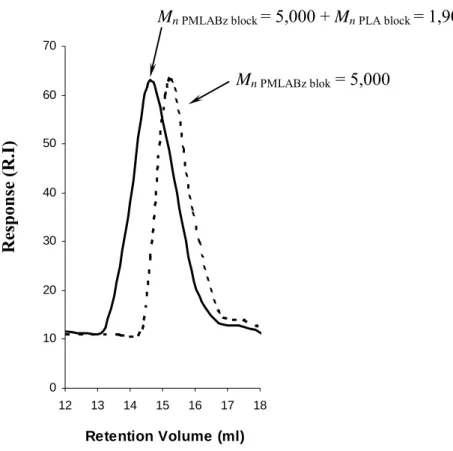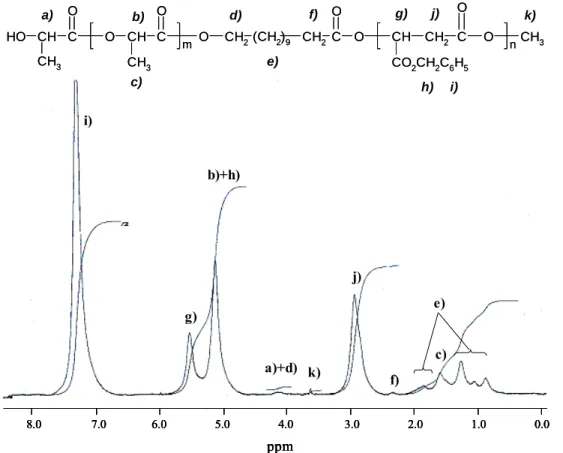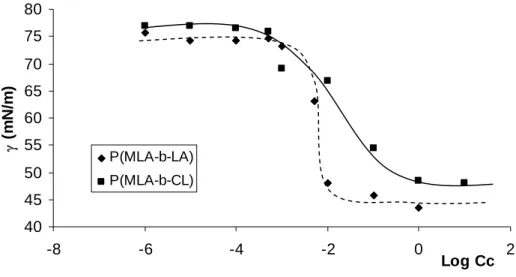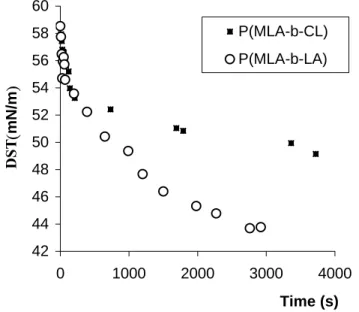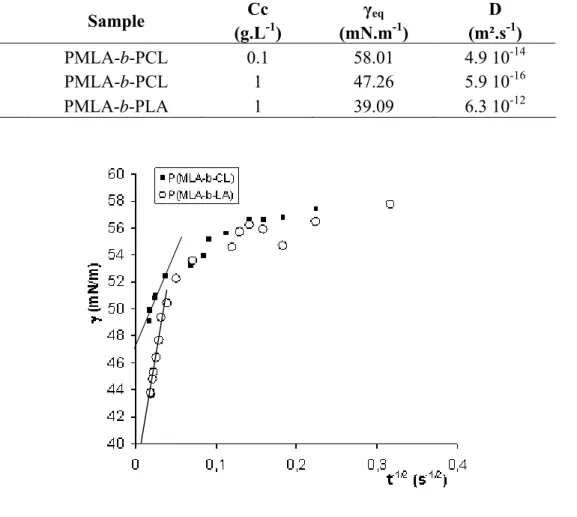RESEARCH OUTPUTS / RÉSULTATS DE RECHERCHE
Author(s) - Auteur(s) :
Publication date - Date de publication :
Permanent link - Permalien :
Rights / License - Licence de droit d’auteur :
Dépôt Institutionnel - Portail de la Recherche
researchportal.unamur.be
University of NamurBenzyl -malolactonate
Coulembier, Olivier; Ghisdal, Jessica; Degée, Philippe; Dubois, Philippe
Published in:
ARKIVOC
Publication date:
2007
Document Version
Publisher's PDF, also known as Version of record
Link to publication
Citation for pulished version (HARVARD):
Coulembier, O, Ghisdal, J, Degée, P & Dubois, P 2007, 'Benzyl -malolactonate: Synthesis, copolymerization and design of novel biodegradable macromolecular surfactants', ARKIVOC, vol. 2007, no. 10, pp. 57-70.
General rights
Copyright and moral rights for the publications made accessible in the public portal are retained by the authors and/or other copyright owners and it is a condition of accessing publications that users recognise and abide by the legal requirements associated with these rights. • Users may download and print one copy of any publication from the public portal for the purpose of private study or research. • You may not further distribute the material or use it for any profit-making activity or commercial gain
• You may freely distribute the URL identifying the publication in the public portal ?
Take down policy
If you believe that this document breaches copyright please contact us providing details, and we will remove access to the work immediately and investigate your claim.
Benzyl β-malolactonate: synthesis, copolymerization and design of
novel biodegradable macromolecular surfactants
Olivier Coulembier, Jessica Ghisdal, Philippe Degée, and Philippe Dubois*
Laboratory of Polymeric and Composite Materials (LPCM), University of Mons-Hainaut, Place du Parc 20, B-7000 Mons, Belgium
E-mail: philippe.dubois@umh.ac.be
Dedicated to Professor Alain Krief on his 65th birthday
Abstract
Racemic [R,S] benzyl β-malolactonate monomer (MLABz) was synthesized according to the well-established “aspartic acid” route and purified to such an extend that it allowed the controlled synthesis of poly([R,S] β-malic acid)-b-poly((D,L)-lactide) diblock copolymers by a versatile three-step pathway combining anionic and coordination-insertion ROP of MLABz and lactide monomers, respectively. For the sake of comparison, amphiphilic poly([R,S] β-malic acid)-b-poly(ε-caprolactone) diblock copolymers of identical composition were synthesized as well. The associating behavior of monodisperse diblock copolymers consisting of water-soluble poly(β-malic acid) block and hydrophobic polylactide or poly(ε-caprolactone) block was studied in aqueous solution. Accordingly, both types of copolymers were dissolved directly in water and (dynamic) surface tension measurements were carried out. It came out that poly(β-malic acid)-b-poly((D,L)-lactide) amphiphilic diblock copolymers showed tensioactive properties with a lower critical micellar concentration, a higher efficiency of adsorption and a better monomer coefficient diffusion compared to corresponding poly(β-malic acid)-b-poly(ε-caprolactone) diblock copolymers of comparative composition.
Keywords: [R,S]Benzyl β-malolactonate, lactide, amphiphilic copolymer, surfactant,
biodegradablility, surface tension
Introduction
The controlled synthesis and thorough characterization of well-defined (macro)molecular structures is prerequisite to the development of new polymeric materials with tunable properties, whatever the application. For instance, preparation of drug delivery systems made from biodegradable, biocompatible and amphiphilic diblock copolymers requires to meet specific
material properties that can only be reached by controlling the polymerization and macromolecular parameters. The synthesis of such diblock copolymers can be achieved by sequential addition of hydrophobic and hydrophilic monomers starting from an asymmetric difunctional initiator.
Because of the versatile functionalities available, the polymerization of β-malolactonic acid esters has been chosen as a precursor for the hydrophilic block.1 Owing to pioneering works by Einhorn,2 Lenz,3 and Guérin,4-6 a large family of β-substituted β-lactones, i.e. malolactonic and alkylmalolactonic acid esters, can currently be synthesized starting from either (3-alkyl)aspartic acid or (3-alkyl)malic acid (racemic or optically active derivatives).1 As far as the overall yield is concerned, these multistep reactions, namely called “aspartic acid” and “malic acid” routes, are quite similar reaching about 20 to 30% yield. It is worth noting that the purification of these lactones is a tricky crucial step and must be finely tuned for each monomer since the synthesis pathway defines the nature of by-products. Moreover, whatever the method used, the purification procedures have to take into account the poor stability of β-substituted β-lactones as well as their high boiling point (~120°C under 10-2 mmHg).
Up to date, high molecular weight polyesters have usually been prepared by anionic ring-opening polymerization (ROP) of substituted β-malolactones using either tetraalkylammonium benzoate 7,8 or potassium alkanoate (added with 18-crown-6 ether) as initiator.9-13 The anionic ROP proceeds by a nucleophilic attack of the carboxylate anion on the carbon atom in β-position of the carbonyl group of the cyclic ester, followed by the O-alkyl cleavage rupture of the β-lactone regenerating an active carboxylate anion. The chain polymerization mechanism occurs via Walden’s configuration inversion without any racemization.14,15 Guérin et al. have synthesized amphiphilic block copolymers composed of poly(β-malic acid) (PMLA) hydrophilic block and poly(butyl malate) or poly(butyl 3-methyl malate) hydrophobic segments through the sequential anionic copolymerization of benzyl β-malolactonate and butyl malolactonate comonomers, followed by selective hydrogenolysis of benzyl ester groups.9 Recently, we reported on the controlled synthesis of well-defined biodegradable and biocompatible amphiphilic poly(β-malic acid)-b-poly(ε-caprolactone) diblock copolymers (PMLA-b-PCL) according to a three-step strategy.10 The resulting copolymers proved to form micelles in aqueous solution characterized by a fairly narrow size distribution and low critical micellar concentration (CMC) dependent on the PMLA-b-PCL copolymer composition.16
This paper aims at reporting on the synthesis procedure for producing well-defined biodegradable and biocompatible poly(β-malic acid)-b-polylactide diblock copolymers (PMLA-b-PLA) with controlled composition and molecular weight. Their tensioactive properties have been investigated in water by surface tension experiments and compared to those of PMLA-b-PCL diblock copolymers. Dynamic surface tension (DFT) and adsorption of PMLA-based copolymers at the air-water interface has been particularly examined.
Results and Discussion
Synthesis of poly(β-malic acid)-b-polylactide amphiphilic diblock copolymers. The
polymerization of 4-benzyloxycarbonyl-2-oxetanone, also called benzyl β-malolactonate (MLABz), requires first its synthesis and careful purifications. Since several synthetic procedures have already been published,3,5,6,17 the preparation of racemic MLABz has been carried out according to the well-established “aspartic acid” route beginning with racemic aspartic acid (Scheme 1).18 As previously reported for the synthesis of poly(β-malic acid)-b-poly(ε-caprolactone) diblock copolymers (PMLA-b-PCL),10 a three-step strategy combining the anionic polymerization of benzyl β-malolactonate (MLABz) with the coordinative ring-opening polymerization (ROP) of (D,L)-lactide (LA), followed by the selective removal of benzyloxy protective groups, has been adopted for the synthesis of amphiphilic poly(β-malic acid)-b-polylactide (PMLA-b-PLA) diblock copolymers (Scheme 2).
O OH NH2 OH O O OH Br OH O O Br O O O OH Br O O O O O O CH2 OH O O Br OH O (D,L)-Aspartic acid NaNO2 NaBr, H2SO4 (R,S)-Bromosuccinic acid TFAA (R,S)-Bromosuccinic anhydride
+
Mixture of α and β (R,S)-bromoesters
1) pH 7.2 2) CH2Cl2/H2O
(R,S) benzyl β−malolactonate monomer
with TFAA : Trifluoroacetic anhydride
Scheme 1. Overall synthesis of [R,S] benzyl β-malolactonate monomer via the “aspartic acid”
O H (CH2)11
O
O + n O
O
COOR 1. Anionic ROP 2. H3O+ 3. (CH3)3SiCHN2 O H (CH2)11 O O CH CH2 O O CH3 COOR n α-hydroxy-ω-methyl P(MLABz) 1. AlEt3 2. m/2 O (CH2)11 O O CH CH2 O O CH3 COOR n O O H m CH CH3 P(MLABz-b-LA) Deprotection H2, Pd/C P(MLA-b-LA) 3. H3O+ with R = -CH2-C6H5 Coordinative ROP K+ HDD MLABz + 18-crown-6 O O O O O (CH2)11 O O CH CH2 O O CH3 n O O H m CH CH3 COOH
Scheme 2. Three-step synthesis of poly(β-malic acid)-b-poly((D,L)-lactide) (PMLA-b-PLA)
diblock copolymer.
Typically, according to this three-step strategy, the polymerization of MLABz (0.2 mol.L-1) has been initiated by potassium 11-hydroxydodecanoate added with 18-crown-6 ether (HDD) in THF for 70 min at 0°C and for an initial monomer-to-HDD molar ratio of 24. Assuming that each chain is end-capped by a hydroxyl group at one extremity and a carboxylic acid function at the other chain-end, an experimental molar mass (MnNMR) of 5,000 could be determined by 1 H-NMR spectroscopy from the relative intensity of the methine protons of the main chain at 5.45 ppm (-CH(COOR)-CH2-COO-) and the α-hydroxyl methylene protons at 3.7 ppm (HO-CH2
-(CH2)10-COO-). The experimental molar mass agreed well with the theoretical value, assuming a
“living” polymerization reaction, i.e., occurring without any transfer and termination reactions. Moreover, the molecular weight distribution of the as-obtained α-hydroxyl, ω-carboxylic acid poly(benzyl β-malolactonate) (PMLABz) has proved to be unimodal with a narrow polydispersity index (Mw/Mn = 1.2) as determined by size exclusion chromatography (SEC).
Before sequential polymerization of racemic (D,L)-lactide (LA), the α-hydroxy, ω-carboxylic acid PMLABz has been reacted with an excess of trimethylsilyldiazomethane in toluene/methanol (9:1) at r.t. for 1 h to selectively protect the carboxylic acid end-group and avoid any side-reactions with triethylaluminum (AlEt3) used as activator in the subsequent
ring-opening polymerization (ROP) step. 1H-NMR spectroscopy of the as-formed α-hydroxyl, ω-methyloxycarbonyl poly(benzyl β-malolactonate) (α-OH PMLABz) has attested the completion of the methylation reaction with a signal intensity ratio of 3/2 between methyloxycarbonyl end-groups protons at 3.65 ppm and hydroxymethylene ones at ~3.8 ppm. Both the polydispersity index and molar mass of α-OH PMLABz chains remain unchanged and under control (Table 1).
Similarly to the synthesis of PMLA-b-PCL diblock copolymers,10 the controlled polymerization of (D,L)-lactide (LA) has been initiated by the α-hydroxyl extremity of the poly(β-malolactonate) chains after previous activation into diethylaluminum monoalkoxide active end-groups by adding a slight excess of AlEt3 ([AlEt3]0/[OH]0 = 1.1). The polymerization
has been carried out at 70°C in toluene for an initial monomer concentration of 0.43 mol.L-1 and two monomer-to-macroinitiator ([LA]0/[OH]0) molar ratios in order to tune the molecular weight
of the PLA block (Table 1). After a given reaction time, the diethylaluminum alkoxide growing species have been selectively deactivated by the addition of a few drops of a HCl aqueous solution (0.1 mol.L-1), and the poly(benzyl β-malolactonate)-b-poly((D,L)-lactide) diblock copolymers (PMLABz-b-PLA) have been recovered by precipitation from cold methanol. Monomer conversions and weight fractions in PLA have been determined by gravimetry while PLA number average molar mass has been estimated by 1H-NMR spectroscopy (Table 1).
Table 1. Experimental conditions and molecular parameters of PMLABz-b-PLA block
copolymers as obtained by ROP of LA at 70°C and initiated by α-hydroxy, ω-methyloxycarbonyl PMLABz (α-OH PMLABz) after previous activation with a slight excess of AlEt3
α-OH PMLABz PLA
Entry Mn (g/mol) Mw/Mn [LA]0/ [OH]0 t(h) Conv.a (%) Mnthb (g/mol) Mnexpc (g/mol) Fwd (%) Mw/Mn e 1 5,000 1.2 35 30 40 2,000 1,900 0.27 1.43 2 5,000 1.2 70 400 90 9,100 9,000 0.64 bimodal
aMonomer conversion as determined by gravimetry. bTheoretical number average molar mass of
the PLA block : Mnth = 144 x [LA]0/[OH]0 x Conv.(%). cPLA number average molar mass as
determined by 1H-NMR spectroscopy : Mnexp = 144 x [I1.6/I3.65]. dPLA weight fraction in the
copolymer as determined by 1H-NMR /gravimetry. eNumber average molar mass and polydispersity index as determined by SEC in THF at 35°C with reference to polystyrene standards.
In agreement with already published data,19 the ROP of LA as initiated by aluminum alkoxide derivatives is much slower than the polymerization of CL under similar experimental conditions. Moreover, due to the quite low concentration in both monomer and macroinitiator, more than 2 weeks are required to reach high monomer conversion (entry 2 in Table 1). It results that a loss of control occurs when high monomer conversion and high molar mass in PLA are targeted. It is likely due to the occurrence of undesirable transesterification reactions. In contrast, for lower reaction time (entry 1 in Table 1), the molecular weight distribution of PMLABz-b-PLA diblock copolymer is monomodal with a SEC trace shifted to lower retention volume compared to the curve of the starting α-hydroxy PMLABz macroinitiator (Figure 1).
0 10 20 30 40 50 60 70 12 13 14 15 16 17 18 Retention Volume (ml)
Mn PMLABz block = 5,000 + Mn PLA block = 1,900
Mn PMLABz blok = 5,000
R
esponse
(R
.I)
Figure 1. SEC traces of PMLABz-b-PLA block copolymer (full line) and PMLABz
macroinitiator (dash line) (entry 1, Table 1).
Figure 2 shows the 1H-NMR spectrum of the isolated PMLABz-b-PLA diblock copolymer (Table 1, entry 1). In addition to the signals assigned to PMLABz and PLA blocks, a minor resonance at 3.65 ppm, attributed to the ω-methyloxycarbonyl protons end-groups, has allowed calculating the number average molecular weight of each block (MnPLA = 144 x [I1.6/I3.65] =
1,900; MnPMLABz = 206 x [I5.6/(I3.65/3)] = 5,000).
The last step in the synthesis of amphiphilic poly(β-malic acid)-b-polylactide (PMLA-b-PLA) diblock copolymer relies upon the catalytic hydrogenation reaction of benzyl ester functions anchored all along the PMLABz block. As hydrogenation reaction proceeds, the relative intensity of both phenylic and benzylic protons at 7.2 and 5.1 ppm, respectively, decrease. Under such prevailing conditions, the deprotection is close to be quantitative after 8.5 hours as attested by 1H-NMR spectroscopy. As previously observed for PMLA-b-PCL diblock copolymer,10 the generated carboxylic acid functions form strong hydrogen bonding with the carbonyl ester groups, at least in a solvent such as acetone-d6 ((CD3)2CO) (not shown here). No
resonance signal typical of carboxylic acid functions could be detected at low field, i.e. around 10 ppm. Interestingly, catalytic hydrogenation preserved polyester chain integrity since the polymerization degree of both segments are kept unchanged. Table 2 (entry 2) shows the molecular characteristics of the as-obtained PMLA-b-PLA amphiphilic diblock copolymer.
8.0 7.0 6.0 5.0 4.0 3.0 2.0 1.0 0.0 ppm O H CH C CH3 O O CH CH3 C O O CH2(CH2)9 CH2C O O CH CO2CH2C6H5 CH2 C O O CH3 m n a) b) c) d) e) f) g) h) i) j) k) a)+d) b)+h) c) e) f) g) j) i) k) 8.0 7.0 6.0 5.0 4.0 3.0 2.0 1.0 0.0 ppm 8.0 7.0 6.0 5.0 4.0 3.0 2.0 1.0 0.0 ppm 8.0 7.0 6.0 5.0 4.0 3.0 2.0 1.0 0.0 ppm O H CH C CH3 O O CH CH3 C O O CH2(CH2)9 CH2C O O CH CO2CH2C6H5 CH2 C O O CH3 m n a) b) c) d) e) f) g) h) i) j) k) a)+d) b)+h) c) e) f) g) j) i) k)
Figure 2. 1H-NMR spectrum (in CDCl3) of PMLABz-b-PLA diblock copolymer. (Mn PMLABz =
5,000 ; Mn PLA = 1,900).
Table 2. Molecular characteristics, adsorption efficiency, Γ, area/molecule at surface saturation, a, and critical micelle concentration, CMC, at r.t of a PLA and a comparative PMLA-b-PCL diblock copolymer of equivalent composition
Entry Sample Mn PMLA (g.mol-1) Mn PCL (g.mol-1) Mn PLA (g.mol-1) Γ (10-10 moles/cm²) a (Ų) CMC (g.L-1) 1 PMLA-b-PCL11 3,800 2,500 - 0.66 250 1.86 2 PMLA-b-PLA 3,800 - 2,000 10.3 16 0.016
Dynamic surface tension and adsorption mechanisms of poly(β-malic acid)-based copolymers at the air-water interface
Figure 3 shows the semilogarithmic plot of the surface tension of both PMLA-b-PCL and PMLA-b-PLA diblock copolymers versus their concentration in water (expressed in g.L-1) at r.t.
40 45 50 55 60 65 70 75 80 -8 -6 -4 -2 0 2 Log Cc γ (m N /m ) P(MLA-b-LA) P(MLA-b-CL)
Figure 3. Concentration (Cc) dependence of the surface tension (γ) of amphiphilic
PMLA-b-PCL ( , full line) and PMLA-b-PLA (♦, dash line) diblock copolymers (see Table 2) in aqueous solution at r.t.
From the γ vs. logCc plot, the critical micellar concentration (CMC), surface area per molecule at surface saturation (a), and adsorption efficiency (Γ) have been determined for the two copolymers. The CMC values have been determined from the intersection between the tangents drawn from higher concentration portions of the sigmoidal plots,16,20,21 while a and Γ have been calculated from the Debye-Hückel theory using equations 1 and 2, respectively.
T Cc RT ⎟⎟⎠ ⎞ ⎜⎜ ⎝ ⎛ − = Γ ) (log 606 . 4 1 δ δγ (1) Γ = N a 1016 (2)
where N is the Avogadro constant.
Many industrial and technological processes use surfactant solutions under nonequilibrium conditions, and therefore dynamic surface tension (DST or γ (t)) is an important property.22 The
dynamic adsorption, Γ(t), has been described by Ward and Tordai as a diffusion-controlled process23 but due to an incalculable Volterra integral accounting for back diffusion from the
subsurface the equation cannot be solved analytically. More interestingly Miller has shown that solutions of the Ward-Tordai equation can be obtained from the DST curves22-24 focusing on γ(t)
at short times, where the tension is close to that for the pure solvent γ0, and γ (t) at long times,
2 / 1 0 0 0 2 ) ( ⎟ ⎠ ⎞ ⎜ ⎝ ⎛ − = → γ π γ t t RTC Dt (3a) Dt C RT t t eq 4 2 ) ( 0 2 π γ γ →∞ = + Γ (3b)
where C0, Γ and D denote the initial “bulk” surfactant concentration, equilibrium surface excess,
and monomer diffusion coefficient of the surfactant in solution, respectively. DST for PMLA-b-PLA diblock copolymer has been determined for an initial concentration of 1 g.L-1 while DSTs of PMLA-b-PCL have been investigated at 1 and 0.1 g.L-1. Figure 4 shows DST curves for 1 g.L
-1 solutions. Whatever the copolymer solution, starting values of surface tension are lower than
the ones of pure water (~ 72 mN.m-1) though data acquisition time is about 10 ms. γeq values
have been obtained as the intercept with Y-axis of γ vs. t-1/2 plots linear parts, while monomer coefficient diffusion, D, has been determined from the slopes (Figure 5, Table 3).
42 44 46 48 50 52 54 56 58 60 0 1000 2000 3000 4000 Time (s) DST (mN/m ) P(MLA-b-CL) P(MLA-b-LA)
Figure 4. Dynamic surface tension of the PMLA-b-PCL ( ) and PMLA-b-PLA (ο) diblock copolymers at r.t. for an initial concentration in aqueous solution of 1 g.L-1.
As might be expected from the relative mobility below the subsurface,25 the self-diffusion of the amphiphilic PMLA-b-PCL diblock copolymer, from the bulk to the interface sharply decreases with the concentration in surfactant (entries 1 and 2 in Table 3). If the solution concentration is high, i.e. 1 g.L-1, the diffusion of the amphiphilic structure is hindered. Substituting PLA block for PCL is responsible for a drastic decrease of D resulting in a smaller CMC and a higher efficiency of adsorption (Table 2). In comparison to recently reported data on
poly(ethylene oxide)-b-poly(ε-caprolactone) PEO-b-PCL diblock copolymers,25 the monomer
coefficient diffusion of the PMLA-b-PLA is in the same range of magnitude (D(PEO-b-PCL) = 2-12
.10-11 m².s-1) meaning that such copolyesters undoubtedly represent good candidates for pharmaceutical applications.
Table 3. Monomer coefficient diffusion, D, of PMLA-based copolymers varying their structure
and initial solution concentration
Entry Sample Cc (g.L-1) γeq (mN.m-1) D (m².s-1) 1 PMLA-b-PCL 0.1 58.01 4.9 10-14 2 PMLA-b-PCL 1 47.26 5.9 10-16 3 PMLA-b-PLA 1 39.09 6.3 10-12
Figure 5. Plot of surface tension vs t-1/2 for the PMLA-b-PCL ( ) and PMLA-b-PLA (○) diblock copolymers at r.t. (initial concentration = 1 g.L-1).
In conclusion, synthesis of polymerization grade benzyl β-malolactonate has allowed synthesizing new controlled poly(β-malic acid)-b-polylactide diblock copolymers by a versatile route combining anionic and coordinative ROP of the (di)lactones. These amphiphilic PMLA-b-PLA diblock copolymers proved to form micelles in aqueous solution which are characterized by a smaller CMC, a higher efficiency of adsorption and better monomer coefficient diffusion compared to amphiphilic PCL diblock copolymers of similar composition. PMLA-b-PLA diblock copolymers, actually based on biodegradable polyester sequences, are expected to
find applications in the biomedical area, e.g., as drug carriers in controlled delivery (nano)systems.
Experimental Section
General Procedures. Petroleum ether (ChemLab, p.a.), heptane (ChemLab, 99%), methanol
(ChemLab, extradry), acetic acid (ChemLab, p.a.), Celite® (ChemLab), potassium (Acros, 98%), naphthalene (Acros, 99%), trimethylsilyldiazomethane (2N in hexane from Aldrich), triethylaluminum (1.8 M in toluene from Fluka), NaOH (Acros, pellets p.a.), HCl (Acros, p.a. 37%), Pd/C (10 wt% from Aldrich) and hydrogen (Air Liquide, >99.999%) were used without further purification. [R,S] benzyl β-malolactonate (MLABz) was stored at –18°C, distilled under reduced pressure and dried by three successive azeotropic distillations of toluene just before use. (D,L)-Lactide (Boehringer-Ingelheim, 99+%) was recristallized three times in dried toluene (20% wt/vol) at 70°C and then dried under vacuum overnight. 11-Hydroxydodecanoic acid (Aldrich, 97%), and 18-crown-6 (Acros, 99%) were dried by three successive azeotropic distillations of toluene. Benzyl alcohol (Acros, 99%) was dried over calcium hydride at r.t. for 48 h and then distilled under reduced pressure. Toluene (Labscan, 99%) and tetrahydrofuran (THF) (Labscan, 99%) were dried by refluxing over CaH2 and Na/benzophenone complex, respectively.
Just before use, THF was further dried over low molecular weight ω-lithium styryl poly(styrene) and then distilled under reduced pressure.
Preparation of micellar solutions. A Millipore Milli-Ro® 4 water purification system with
resistance around 18MΩ.cm was used to purify water needed for the preparation of the amphiphilic copolymer solutions. Stock amphiphilic (co)polymer solutions were prepared at room temperature by dissolving a defined amount of (co)polymer in purified water (Cc = 1 g.L-1) and filtered through 1.2 µm Acrodisk® filter. Solutions of lower concentration were obtained by subsequent dilutions of the stock solutions.
Characterizations. 1H-NMR spectra were recorded using a Bruker AMX-300 apparatus at r.t. in CDCl3 except otherwise mentioned (30 mg/0.6 ml). Size exclusion chromatography (SEC) was
performed in THF at 30°C using a Polymer Laboratories liquid chromatograph equipped with a PL-DG802 degasser, an isocratic HPLC pump LC 1120 (flow rate = 1mL/min), a Rheodin manual injection (loop volume = 200 µL, solution conc. = 2 mg/mL), a PL-DRI refractive index detector, a Viscotek 270 dual detector (viscometer and right angle laser light scattering) and four columns : a PL gel 10 µm guard column and three PL gel Mixed-B 10 µm columns (linear columns for separation of MWPS ranging from 500 to 106 daltons). A poly(styrene) standard was
used for the equipment calibration (PS 90K, Mp = 89,300, Mw = 90,100, Mn = 86,700, IV =
0.439 dlg-1). The (dynamic) surface tensions were determined using a DROP SHAPE ANALYSIS SYSTEM DSA 10 Mk2 equipped with a thermostated chamber and a Circulator Thermo HAAKE DC 10.
Anionic ring-opening polymerization of benzyl β-malolactonate. In a previously flamed and
nitrogen purged round bottom flask, 1.0 g (7.8 mmol.) of naphthalene was added with 0.37 g (9.5 mmol.) of potassium and 39 mL of THF. After an overnight reaction, a deep green colored solution of potassium naphthalene radical anion was obtained (conc. 0.2 mol.L-1). In another previously flamed and nitrogen purged round bottom flask, 0.52 g (1.97 mmol.) of 18-crown-6 ether and 0.43 g (1.97 mmol.) of 11-hydroxydodecanoic acid were dissolved in 10 mL of THF and then added with an equimolar amount of the solution of potassium naphthalene radical anion (10.0 ml, 1.97 mmol, [HDD] = 0.1 mol.L-1). The polymerization of (R,S) benzyl β-malolactonate (MLABz) (2.0 g, 9.7 mmol) was typically conducted in a previously flamed and nitrogen purged round bottom flask equipped with a three-way stopcock and a septum by initiation with the complex formed between potassium 11-hydroxydodecanoate and 18-crown-6 ether (4.0 ml, 4.0 x 10-4 mol) in THF (42.5 ml) at 0°C. After 70 min., the polymerization was stopped by adding a few drops of aqueous HCl (0.1 mol.L-1). After evaporation of the solvent, the product was dissolved in dichloromethane (20 ml) and extracted three times with a saturated aqueous KCl solution (3 x 20 ml) and with deionized water (3 x 20 ml). Finally, the organic layer was poured into 8 volumes of cold heptane (160 ml). The polymer was recovered by filtration and dried under reduced pressure at 40 °C until constant weight, i.e., 1.6 g. Yield 79%. 1H-NMR (300 MHz, CDCl3, δ ppm) 0.8-1.8 (m, 18H), 2.25 (t, 2H), 2.8 (m, 2H), 3.7 (t, 2H), 4.9-5.1 (s, 2H),
5.45 (m, H) and 7.3 (s, 5H).
Methylation of α-hydroxy, ω-carboxylic acid poly(benzyl β-malolactonate). In a previously
flamed and nitrogen purged round bottom flask equipped with a three-way stopcock and a septum, 1.3 g of α-hydroxy, ω-carboxylic acid poly(benzyl-β-malolactonate) (2.6 x 10-4 mol, Mn
= 5,000, Mw/Mn = 1.2) were dried by three successive azeotropic distillations of toluene (3 x 10
ml). Then, the dried polymer was dissolved in a mixture of 20 mL of toluene and 2 mL of anhydrous methanol. Three equivalents of trimethylsilyldiazomethane (6.0 x 10-4 mol, 0.30 ml) compared to the content of carboxylic acid functions were then added. Nitrogen gas evolved through a connected oil valve. After 1 h, the reaction was stopped by the addition of a few drops of acetic acid (0.1 mol.L-1) and the volatiles were removed out under reduced pressure. The polymer was recovered by precipitation into 8 volumes of cold heptane (160 ml), filtration and drying under reduced pressure at 40 °C until constant weight, i.e., 1.3 g. Yield >99%. 1H NMR (300 MHz, CDCl3, δ ppm) 0.8-1.8 (m, 18H), 2.25 (t, 2H), 2.8 (m, 2H), 3.7 (t, 2H), 3.65 (s, 3H
from –C(O)OMe), 4.9-5.1 (s, 2H), 5.45 (m, H) and 7.3 (s, 5H).
Synthesis of poly(benzyl β-malolactonate)-b-poly((D,L)-lactide) diblock copolymer. In a
previously flamed and nitrogen purged round bottom flask equipped with a three-way stopcock and a septum, 1.3 g of α-hydroxy, ω-methyloxycarbonyl poly(benzyl-β-malolactonate) (2.6 x 10-4 mol, Mn = 5,000, Mw/Mn = 1.2) were dried by three successive azeotropic distillations of toluene
(3 x 10ml). Then, the dried polymer was reacted with 1.1 equivalent of triethylaluminum compared to the content of hydroxyl functions (2.86 x 10-4 mol, 2.9 ml) in toluene at 50°C for 2 h. Ethane evolved through a connected oil valve. After cooling down to r.t., the α-diethylaluminum, ω-methyloxycarbonyl poly(benzyl β-malolactonate) solution was transferred
using a previously flamed capillary to a second flamed an nitrogen purged round bottom flask equipped with a three-way stopcock and a septum containing 0.52 g of (D,L)-lactide (3.6 x 10
-3mol) previously dried by three successive azeotropic distillations of toluene ([LA]
0 ~ 0.43
mol.L-1). The medium was then heated up to 70°C and the polymerization was conducted for 30 hours. After addition of a few drops of a HCl aqueous solution (0.1 mol.L-1), the polymer solution was washed three times with an aqueous solution of ethylenediaminetetraacetic acid (EDTA) buffered at pH 4.8 (0.1 mol.L-1) (3 x 20 ml) and with deionized water (3 x 20 ml). The organic layer was poured into 8 volumes of cold methanol (160 ml). The copolymer was recovered by filtration and dried under reduced pressure at 40 °C until constant weight (1.5 g). Yield = 83%. 1H-NMR (300 MHz, CDCl3, δ ppm, see Figure 2) 0.8-1.8 (m, 18He+3Hc), 2.30 (t,
2Hf), 2.8 (s, 2Hj), 3.65 (s, 3Hk), 4.05-4.2 (m, 2Hd+1Ha), 5.1 (s, 2Hh+1Hb), 5.45 (s, Hg) and 7.2 (s,
5Hi). Mn blockPMLABz = 5,000; Mn blockPLA = 1,900 and Mn (PMLABz-b-PLA) = 6,900. Mw/Mn =
1.4.
Removal of benzyl ester protective groups. In a round bottom flask, 1.0 g of PMLABz-b-PLA
copolymer (1.45 x 10-4 mol, Mn = 6,900) was dissolved into 200 mL of acetone at r.t. and then
added with 0.2 g of Pd/C 10wt%. A continuous flow of hydrogen was bubbled into the solution for 8.5 h. After filtration through Celite, a clear copolymer solution was obtained. The solvent was evaporated under reduced pressure (10 mmHg) before recovering the polymer by extensive drying at 40°C under reduced pressure (0.5 g). Yield = 72%. 1H-NMR (300 MHz,CD3COCD3, δ
ppm) 0.8-1.8 (m, 18He+3Hc), 2.30 (t, 2Hf), 2.8 (s, 2Hj), 3.8 (s, 3Hk), 4.05-4.2 (m, 2Hd+1Ha), 5.1
(s, 1Hb) and 5.45 (s, Hg). Mn blockPMLA = 3,800; Mn blockPLA = 2,000 and Mn (PMLA-b-PLA) =
5,800.
Acknowledgements
This work was partially supported by both the Région Wallonne and European Union “FSE and FEDER” in the frame of Objectif 1-Hainaut: Materia Nova. O.C. is grateful to F.R.I.A. for his Ph.D. grant. LPCM thanks the Belgian Federal Science Policy Office for general support in the frame of the SSTC-PAI-5/03.
References
1. Cammas-Marion, S.; Guérin, Ph. Macromol. Symp. 2000, 153, 167. 2. Einhorn, A. Ber.1883, 16, 2208.
3. Arnold, S.C.; Lenz, R.W. Makromol.Chem., Macromol. Symp. 1986, 6, 285. 4. Guérin, Ph.; Vert, M.; Braud, C.; Lenz, R.W. Polym. Bull. 1985, 14, 187. 5. Guérin, Ph.; Vert, M. Polym.Commun. 1987, 28, 11.
7. Mabille, Ch.; Masure, M.; Hémery, P.; Guérin, Ph. Polym. Bull. 1998, 40, 381.
8. Coulembier, O.; Degée, Ph.; Barbaud, Ch..; Guérin, Ph.; Dubois, Ph. Polym.Bull. 2004, 51, 365.
9. Cammas-Marion, S.; Béar, M.M.; Harada, A.; Guérin, Ph.; Kataoka, K. Macromol. Chem. Phys. 2000, 201(3), 355.
10. Coulembier, O.; Degée, Ph.; Cammas-Marion, S. ; Guérin, Ph.; Dubois, Ph. Macromolecules
2002, 35, 9896.
11. Coulembier, O.; Degée, Ph.; Gerbaux, P.; Wantier, P.; Barbaud, Ch.; Flammang, R.; Guérin, Ph.; Dubois, Ph. Macromolecules 2005, 38, 3141.
12. Rieger, J.; Coulembier, O.; Dubois, Ph.; Bernaerts, K. V.; Du Prez, F. E.; Jérôme, R.; Jérôme, C. Macromolecules 2005, 38, 10650.
13. Coulembier, O.; Degée, Ph.; Dubois, Ph. Macromol. Chem. Phys. 2006, 207, 484. 14. Guérin, Ph.; Vert, M.; Braud, C.; Lenz, R.W. Polym. Bull. 1985, 124, 187.
15. Leadley, S. R.; Davis, M. C.; Vert, M.; Braud, C.; Paul, A. J.; Shard, A. G.; Watts, J. F. Macromolecules 1997, 30, 6920.
16. Coulembier, O.; Degée, Ph.; Guérin, Ph.; Dubois, Ph. Langmuir 2003, 19, 8661. 17. Vert, M. Polym. Degrad. Stab. 1998, 59, 169.
18. Cammas-Marion, S.; Renard, I.; Langlois, V.; Guérin, Ph. Polymer 1996, 37(18), 4215. 19. Mecerreyes, D.; Jérôme, R.; Dubois, Ph. Adv.in Polym.Sci. 1999, 147, 1.
20. Mukerjee, P.; Mysels, K. J.; Critical Micelle Concentration of Aqueous Surfactant Systems. NSRDS-NBS 36, US Government Printing Office, Washington, DC, 1971.
21. Garibi, H.; Palepu, R.; Tiddy, G. J. T.; Hall, D. G.; Wyne-Jones, E. J. Chem. Soc. Commun.
1990, 2, 115.
22. Chang, C. H.; Franses, E. I. Colloid Surf. 1995, 100, 1. 23. Ward, A. F.; Tordai, L. J.Chem.Phys. 1946, 14, 453.
24. Fainerman, V. B.; Makievski, A. V.; Miller, R. Colloids Surf., A 1994, 87, 61.
25. Vangeyte, P.; Leyh, B. ; Heinrich, M.; Grandjean, J.; Bourgaux, C.; Jérôme, R. Langmuir
